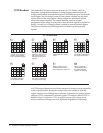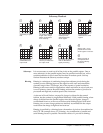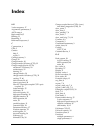
Chapter 3. Advanced CCD Theory 39
Fiberoptics
In most applications, the CCD is illuminated by light from an imaging source
such as a telescope, spectrograph, or microscope. There is a class of applications,
however, in which coherent fiberoptic bundles can be used in place of imaging
optics.
A fiberoptic bundle comprises millions of glass fiber strands, each of which acts
as an individual light pipe. Each strand has a glass cladding that isolates it from
neighboring strands to prevent crosstalk. The optical fibers are carefully stacked
and fused together under heat and pressure to form a solid, rigid coherent
optical transmission element. The fiber boules that are produced in this process
may be reheated and drawn into fiber tapers to meet the needs of specific
applications. Fiberoptic bundles may be twisted 180° to form image inverters.
A fiberoptic bundle may be bonded directly to a CCD, effectively translating the
image plane from the surface of the CCD out to the surface of the fiberoptic
bundle. The interface between the CCD and the fiberoptic must be made with
great care to prevent damage to the delicate CCD surface.
Fiberoptic–coupled CCDs are often used in conjunction with other optical
devices, such as image intensifiers and streak tubes, equipped with matching
fiberoptic outputs. The high light collection efficiency provided by this approach
warrants the additional complexity in fields such as radiography and electron
microscopy, where fiberoptic–coupled CCDs are used to directly image
phosphor screens.
Sources of Noise
All electronic circuitry generates undesirable noise. The effect of this noise on
performance is described by the signal-to-noise ratio (SNR). Photon noise,
preamplifier noise, and dark current noise are the three primary sources of noise
in a CCD camera.
Photon Noise
Photon noise, also known as photonic or photon shot noise, is a fundamental
property of the quantum nature of light. The total number of photons emitted by
a steady source over any time interval varies according to a Poisson distribution.
The charge collected by a CCD exhibits the same Poisson distribution, so that
the noise is equal to the square root of the signal. Photon noise is unavoidable
and is always present in imaging systems; it is simply the uncertainty in the
data.
Preamplifier Noise
Preamplifier noise, also called read noise, is generated by the on-chip output
amplifier. This noise can be reduced to a few electrons with careful choice of
operating conditions.


















